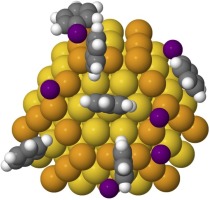Molecular Catalysis ( IF 3.9 ) Pub Date : 2020-02-20 , DOI: 10.1016/j.mcat.2020.110845 Isabela-Costinela Man , Stefan-Gabriel Soriga

|
The experimental evidences show that the nanoplatelets of 20 nm wide and 3−4 nm height, deposited on graphene promote Suzuki cross-coupling reactions. In this regard the adsorption and activation of halobenzene (C6H5Cl(Br/I)), of phenylboronic acid (C6H5B(OH)2) and the formation of biphenyl (C6H5-C6H5) molecules on surfaces that simulates the facets and edges of the gold nanoplatelets, were investigated by means of DFT calculations. The activation and reaction energies of halobenzene molecules are the lowest on the edge between (111)/(100) facets, but even so for C-Cl is relatively high. On all surfaces the energies decrease with decreasing the C–X bond strengths. Therefore, for CI bond the dissociation is possible also on (111), (100) and the edge between (111)/(111) facets. The phenylboronic acid dissociates easily on all surfaces in the presence of adsorbed hydroxyl fragments. The C
C coupling between two phenyl (C6H5) fragments is the least sensitive to the type of sites, being the rate determining step, competing with C-Cl dissociation. The strong adsorption energy of KI molecule indicate possible poisoning of the (111)/(100) edge and of the (111) facet. Overall the studies show a probability of the reaction to take place especially on the edge between (111)/(100) microfacets. If some of the reactions steps are straightforward predicted to take place on the nanoplatelets sites, the reaction steps with higher activation energies are expected to be influenced also by other parameters such as interfaces between nanoplatelets and graphene and which are intended to be studied separately.
中文翻译:

金纳米片位点对C
实验证据表明,沉积在石墨烯上的20 nm宽和3-4 nm高的纳米片促进了Suzuki交叉偶联反应。在这方面,卤代苯(C 6 H 5 Cl(Br / I)),苯基硼酸(C 6 H 5 B(OH)2)的吸附和活化以及联苯(C 6 H 5 -C 6 H )的形成5)通过DFT计算研究了模拟金纳米片的小平面和边缘的表面上的分子。卤代苯分子的活化能和反应能在(111)/(100)面之间的边缘处最低,但即使如此,对于C-Cl来说也相对较高。在所有表面上,能量都随着C–X键强度的降低而降低。因此,对于C I键,在(111),(100)和(111)/(111)小平面之间的边缘上也可能解离。在吸附的羟基片段存在下,苯硼酸很容易在所有表面上解离。
两个苯基之间的C C偶联(C 6 H 5)片段是对位点类型最不敏感的部分,是速率确定步骤,与C-Cl解离竞争。KI分子的强大吸附能表明(111)/(100)边缘和(111)小面可能中毒。总体而言,研究显示出发生反应的可能性,尤其是在(111)/(100)微面之间的边缘。如果某些反应步骤被直接预测会发生在纳米血小板部位,则具有更高活化能的反应步骤也将受到其他参数的影响,例如纳米血小板和石墨烯之间的界面,这些参数将被单独研究。











































 京公网安备 11010802027423号
京公网安备 11010802027423号